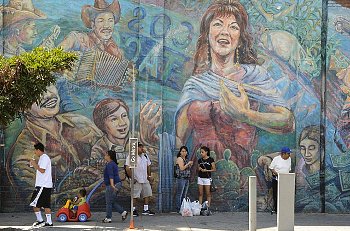
“Root Shock”
Dr. Mindy Fullilove did extensive research and adapted the term “root shock.” Root shock is described as the traumatic stress reaction to the loss of some or all of one’s emotional ecosystem. In her book “Root Shock: How Tearing Up City Neighborhoods Hurts America and What We Can Do About It,” Fullilove examines the history of bulldozing neighborhoods in Black communities between 1949 and 1973 in three different urban settings.
In total, through this federal program lead by businesses and real estate interests, 1,600 neighborhoods were destroyed in the name of urban renewal. This didn’t only affect the Black community living there, making people angry about what was happening, but it also affected the white community causing them to flee from cities into the suburbs.
This is a basic definition and example of root shock. Throughout this time, historical landmarks, places full of the history of Black communities were leveled and reconstructed. This has been the cause and attempt of solid reconstruction for years, some locations have yet to reach their goal.
In more recent examples, Hurricane Sandy, Hurricane Katrina and other natural disasters could be looked at as root shock. Residents in those areas devastated had to relocate and start over. The trauma not only comes from loss but displacement.
Root Shock in Latino Communities
Although this concept of root shock hasn’t been fully written about among Latino communities, the discussion of gentrification can be tied to the same issues of urban renewal. Latino communities have historically been forced out of certain neighborhood in particular cities to make way for reconstruction. Locations, like in the Black community, that have had particular emotional ties or histories have been either closed down or reconstructed, wiping away any community feel that was there before.
The removal of history and the ridding of a solid place to plant roots takes a taxing toll on those experiencing the trauma. Latinos have been part of a gentrification process for some time. In this sense, they have been moved from one location to another due to increase in rent, property taxes and affordability. What was formulated and “rooted” changes and has to begin again elsewhere.
It isn’t as simple as a basic explanation of why this causes problems in community, but the foundation of understanding is similar to the metaphor of having a garden: In order to help your plants grow, you must care for and water them. How can residents plant, water and care for something that continues to be uprooted?
When you have a history that you know about, it’s easy to take pride in the tremendous efforts of the community and those who have come before you to pave the way to where you presently are. It also gives you something to build upon, making yourself better as you propel yourself forward.
The movement of Latino communities is something to be aware of. If movement keeps happening, then how does someone know where they belong?
Cross-Cultural Psychology
This idea of cross cultural psychology brings an interesting twist to the table. This is a branch of psychology that studies how cultural factors influence human behavior. It can be argued that many people have a culture, such as the Latino culture, to depend on. There is a particular culture implemented by friends and family members that cannot be replaced or shaken.
Nonetheless, the Latino culture is implemented at home. Yet, a bigger question comes when you look outside to society; relationships outside the home, opportunities at school and beyond. How does the outside culture then manifest itself in an individual?
If residents of a certain community do not have a unified, safe, plentiful community to be proud of, what happens to those people in the area? This is where Dr. Fullilove expanded on the ideas of the shock in urban communities. If there is a continued displacement, where does one begin again and how is this restructuring begin if no one is there to lead it?
Esta Comunidad No Se Vende
Across a multitude of communities, you find people actively staying put, announcing that their neighborhoods are not for sale, nor do they want to be pushed out of the community. A few examples exist in Chicago with the Humboldt Park neighborhood known for its Puerto Rican heritage, and the Pilsen and Little Village communities known for their Mexican Heritage. San Francisco has the Mission District, while New York has the South Bronx and Spanish Harlem.
With more education in an information-based society, Latinos are trying to keep their communities and what they’ve built regardless of the fact that developers and real estate opportunists may be targeting their particular neighborhoods.
In this sense, they build and continue to build, creating traditions, educating the community about its history and builds pride within the Latino community from the inside out. If the community doesn’t do it, no one else will. Standing ground and reconstructing the community from the inside out might just be the answer to many social issues. Building a community and harnessing the importance of that community will help individuals move forward, understanding their own importance as one crucial piece of a whole.
